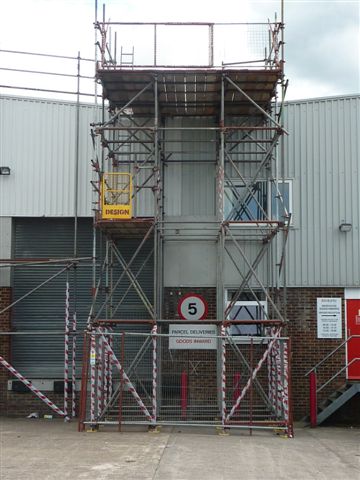In the fast-paced world of construction, bringing a idea to life requires careful planning, expert execution, and the appropriate support systems in place. At the center of many commercial projects lies an unsung hero: scaffolding. Beyond its role as a temporary structure, industrial scaffolding serves as a critical component that enhances productivity, guarantees safety, and enables the seamless execution of intricate builds. Understanding its value is crucial for anyone involved in the building industry.
Beginning with high-rise buildings to retail spaces, the forms of scaffolding used can vary significantly based on job needs. Each type offers distinct benefits and obstacles, making it important to choose the right system for the job at hand. As we explore the multifaceted world of commercial scaffolding, we will examine its importance, safety considerations, and the multiple options available to ensure that your project is not only successful but also compliant with necessary regulations. Follow us as we scaffold your idea, providing perspective into this critical aspect of current construction.

Comprehending Business Scaffold Systems
Commercial scaffolding is a transient structure utilized to hold up work crews and materials during the construction, upkeep, or repair of buildings and other massive projects. It allows workers to access heights safely and efficiently, making it an essential element of modern building practices. This type of scaffolding is designed to accommodate the specific needs of commercial projects, whether it's a high-rise building, a stadium, or a retail space. By providing a sturdy and secure platform, business scaffolding improves the process and productivity of construction teams.
There are different types of scaffolding employed in commercial projects, including modular scaffolding, tube and clamp systems, and system scaffolding. Each type provides distinct advantages depending on the project requirements. Modular scaffolding is favored for its flexibility and ease of assembly, while tube and clamp systems provide versatility for complex structures. Understanding the variations between these types is essential for selecting the right scaffolding for specific applications and ensuring the safety and efficiency of the job site.
The function of scaffolding in construction extends beyond mere support. It boosts job site safety, enables access to hard-to-reach areas, and can be customized to individual project demands. Properly installed scaffolding reduces the risk of accidents and injuries, making compliance with safety regulations a top goal. Additionally, scaffolding is vital for maintaining productivity, allowing workers to conduct their tasks successfully, even when working at significant heights. This foundational understanding lays the groundwork for appreciating the many facets of corporate scaffolding in the building industry.
Safety and Compliance in Scaffold Systems
Security and compliance are paramount in the scaffold industry, as they directly impact worker well-being and the success of projects. Adherence with regulatory standards such as Occupational Safety and Health Administration guidelines ensures that scaffolding systems are designed, built, and maintained correctly. This not only protects workers from accidents but also helps prevent legal complications and costly fines for not complying. Ensuring that scaffold structures is erected correctly and meets all required safety standards is essential for ensuring a secure work environment.
Training is a critical part of scaffold security and compliance. Workers should be knowledgeable in the correct use of scaffolds, potential hazards, and safety procedures. Regular training sessions can reinforce the significance of adhering to security protocols, empowering crews to recognize unsafe conditions and respond appropriately. Moreover, keeping up-to-date records on training can help ensure that all team members are equipped with the most current knowledge and skills required for scaffolding safety.
Performing regular inspections is a further vital aspect of maintaining adherence in scaffold systems. Safety checks should take place prior to, during, and following installation to identify any possible risks or weaknesses in the scaffolding structure. These evaluations should include examinations for structural integrity, load capacity, and general condition of the scaffolding equipment. By actively addressing issues and implementing remedial actions, contractors can greatly reduce the risk of accidents and enhance overall safety on job sites.
Framework Solutions Solutions for Different Applications
Regarding multiple categories of business developments, support systems must be adapted to meet unique requirements and challenges. In the case of tall construction, strong scaffolding systems are essential to ensure worker safety while providing reliable access to higher levels. These projects often use prefabricated scaffolding, allowing efficient assembly and disassembly while accommodating the changing needs of high-rise structures. Tailored scaffolding solutions are also frequent in renovations, where special building layouts necessitate flexible designs to support both recent and existing structures.
Within retail and corporate developments, scaffolding plays a critical role in preserving design integrity while providing functionality. These environments often require scaffolding that minimizes disruption to the adjacent area and improves visibility for shoppers. Scaffolding structures designed for such projects often feature elements that allow convenient access without interfering with day-to-day operations, allowing that operations can continue effectively during construction.
Moreover, massive spaces such as stadiums and schools present distinctive challenges in scaffolding planning and implementation. These projects often demand extensive scaffolding to facilitate construction or renovation activities, ensuring proper safety protocols are in place. Commercial Scaffolding In Margate in these scenarios must account for large crowds and site accessibility, thus necessitating careful planning and execution to ensure the safety of both employees and the public.
